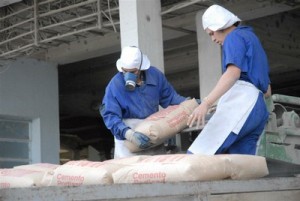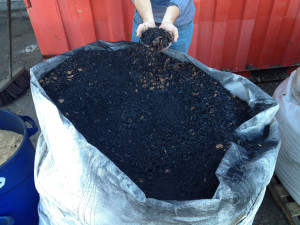
Cuba: From surpluses to shortages
CAMAGÜEY, Cuba — At first, Yariel persevered in his habit of coming to the supply center and asking if this, that or some other construction material had arrived and leaving his telephone numbers to some trusted clerk.
He kept informed about the new arrivals of products that every so often arrived at the center, but they always seemed to be reserved for buyers with a greater priority than his.
So, when he found concrete blocks he couldn’t find construction stone or sand, and his plans were constantly threatened by the possibility that he might not find cement or, as it happened once, that he might find it, buy it and later almost lose it because of problems with the mixer.
With luck, eventually Yariel learned to knock on the right doors. The first thing he learned was that “with the State” he could satisfy his needs with great difficulty or would have to buy those items that no one else wanted. For anything else, he’d have to turn to the private vendors — and sometimes even that wasn’t enough.
“To do construction work in Cuba, it’s not enough to have money or work crews,” Yariel said. “You also need a lot of luck and patience because, when you least expect it, you have to stop production for something as unusual as the unavailability of wire mesh for reinforcements. If you’re unlucky, you can be at a standstill for a couple of months.”
The insufficient production of materials and the hoarding and resale by the middlemen (who hike the prices exponentially) are some of the obstacles that today bedevil Cubans who are engaged in the difficult industry of construction.
What is even worse is that often the products lie undisturbed in some storehouse, snarling the production cycle of the factories that make them, freezing the wages of hundreds or thousands of workers, and adding to the difficulties of potential consumers who could utilize them.
Construction is probably the sector worst affected by such practices. For years, it has been routine for several of the country’s cement factories to function in spurts, due to the insufficient commercialization of their product. In June, the daily Granma reported that the cement industry in Mariel, Artemisa province, was working at 80 percent of capacity because its silos were filled to overflowing.
“Sales have not been in line with the plans for the period, because not all the buyers have shown up. The mill has a production capacity of 3,200 tons a day, but the extraction accounts for about 1,200 tons a day,” said Edilson Ávila, acting deputy manager. What’s most worrisome is that this is not an isolated instance but the dominant trend when it comes to state-run suppliers.

First of all, this is caused by the strict centralization that continues to characterize the Cuban model of management.
“It’s not just the centralization in itself, but also the way that that centralization has been designed,” said recently economist Juan Triana in an interview where he spoke of the low margins of competitiveness that characterize national production vis-à-vis the import trade.
“Worst is the need to apply constantly for permits,” Triana continued. “That excessive centralization has generated one of our worst ills: our minimal capacity to export.”
Generally, the same coordinates apply to the island’s domestic market, which periodically suffers cycles of shortage, due to the insufficient purchases abroad and the inefficiency of Cuban producers and their distribution and commercialization systems.
We can recall cases such as the shortages of toiletries, which virtually disappeared during most of 2013 and 2014, a broad range of household appliances, and construction materials, which still don’t have a stable presence in the commercial network.
Add to this the reductions in the production plans of many items, particularly of manufactured goods for popular consumption. According to the National Office of Statistics and Information, these goods showed negative balances in more than half of their indicators.
To complete the equation, it becomes necessary to lay on the table the complex system of supervisory, distributive and similar institutions that constitute the nation’s entrepreneurial structure.
As an example, articles as needful as iron fittings must travel from the producers to the “central” trading entities (Universal Warehouses and others), to the local trading entities and finally to the points of sale, stores or similar outlets.
Add to this the habitual bureaucratic delays, the problems in transportation and successive storage and you won’t be surprised to learn that, nationwide, the value of “immobilized” goods rises to hundreds of millions of pesos.
The problem has not been solved by the enactment of Decree 315 of November 2103, regulating the sale of “goods that move slowly,” because wholesale markets have still not been created. Also, many institutions see in their reserves a passive asset with which they can overcome adverse junctures, or don’t have the mechanisms or the material motivation to unload such reserves.
Storehouses full, often to capacity, constitute a very unusual conduit to development. All the more so when most of the nation’s demand continues to be unattended, regardless of the sector.
Examples abound, but the most widely known comes from the northeast of Camagüey province. “The October Revolution,” one of the country’s largest manufacturers of fertilizer, is working at a snail’s pace because of the insufficient release of its finished products.
“Every day we could manufacture 350 tons of ammonium nitrate but we can’t, because Ferrocarriles and Transcar, the rail carriers, can take away only 160 tons a day. Until recently, we put the excess in our warehouses but now they’re overstuffed and we can’t continue to store it,” said Benito Jiménez Ibáñez, the company’s production chief, in June.
In the first five months of 2015, “The October Revolution” had to halt production three times because of that bottleneck.
What’s odd about this situation is that, less than 50 kilometers away, in the area of Camalote, farmers pay dearly for fertilizer, and many of them complain of how hard it is to find it, “even with a fistful of cash.”
Would he buy fertilizers for his tomato farm, a farmer was asked. “As much as you bring me,” he answered. Unfortunately, he is not one of the clients that “The October Revolution” is allowed to sell to.


